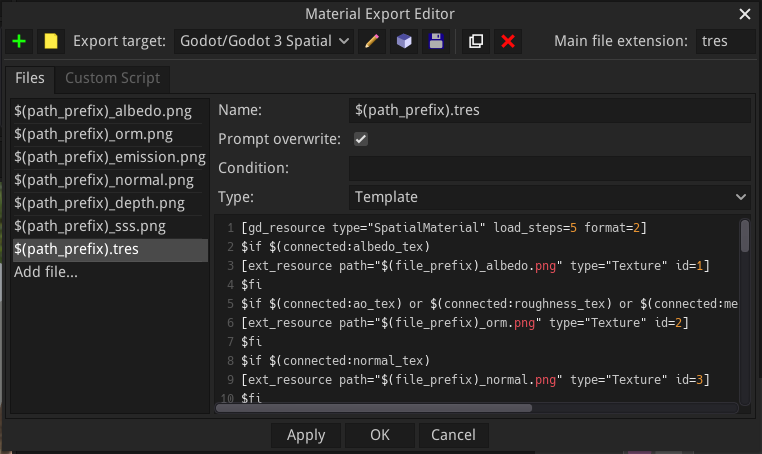Material Maker 1.2
Material Maker » Devlog
Material Maker has been updated to version 1.2, introducing a host of new features, including support for variadic nodes and more flexible material export targets, as well as several new nodes.
I am grateful to everyone who has supported this project through Patreon or by making a donation here on itch.io. I also want to extend my thanks to those who have contributed new nodes or features to Material Maker, suggested new features or reported bugs on Discord or Github, or shared amazing materials on the Material Maker website.
General
- An experimental HTML5 version has been added. Although it has a lot of limitations, it is a good way of trying Material Maker without installing it.
- A dependency manager has been added to handle all parameter changes, buffers and previews to avoid useless renders (myaaaaaaaaa helped hunting and fixing memory leaks on this).
- Material export has been updated:
- export targets, that used to be described in the material nodes editor window, now have a dedicated editor (that can be shown using the node's context menu) with a few minor new features,

- custom export targets can now be added to predefined Material nodes (they are automatically stored in Material Maker's user directory, and can also be loaded from and saved to files),
- a new Export again menu item has been added to quickly repeat the last export operation.
- export targets, that used to be described in the material nodes editor window, now have a dedicated editor (that can be shown using the node's context menu) with a few minor new features,
- Unsaved projects are now rescued when Material Maker crashes and automatically reopened at startup.
Nodes
- Shader nodes can now be variadic, i.e. have a number of parameters, inputs and outputs that are repeated. A new icon in the node titlebar shows the variadic aspect and can be used to increase or decrease the number of occurences of those parameters and ports (just click the icon to add a single occurence of those ports and parameters, or use the context menu to add 2 or 3 at once or remove unused occurrences).
A few nodes have been updated accordingly, so Blend now supports several layers, Transform can apply to several channels and workflow nodes can mix more raw materials.
Making a shader node variadic using the shader node editor is just a matter of adding a # suffix to the names of parameters and ports that must be repeated. Main Code and Instance Functions sections also support the #for ... #end directive to repeat specific parts of the GLSL code (where # is replaced with the instance number). - Two new nodes, Normal to Height and Normal to Height (Simple) have been added. The simple version generates a height map from a normal map in a single pass, and the other uses a second pass to improve the result.

- Parameters have been added to the Image node to keep the image's aspect ratio (contributed by myaaaaaaaaa).
- New colorspace related nodes have been added, such as Colorspace Roundtrip, that make it possible to perform computations in other colorspaces such as HSV and YUV (contributed by myaaaaaaaaa).
- The Fast Blur node now has high pass and sharpened outputs (contributed by myaaaaaaaaa).
- A snap operation has been added to Math nodes (contributed by williamchange).
- The Blend node now has additional modes: Linear Light, Vivid Light, Pin Light, Hard Mix and Exclusion (contributed by paddy-exe).
- The interpolation code has been improved in the 3D FBM node (contributed by Arnklit).
- The random color output of the Triangle Voronoi node, that did not always tile, depending on the scale parameters, has been fixed (contributed by williamchange).
- The Dilate node can now create (optionally) a non-tileable result.
Miscellaneous
- Self-connections of subgraphs are now allowed if they don't form a loop, and loop detection has been optimized (contributed by myaaaaaaaaa). This solves a weird behavior of Material Maker where it was possible to create self connected group nodes (with, of course, no actual loop in the graph) nodes by creating the subgraph after the connections. Loop detection could also take a very long time with group nodes with lots of outputs.
- The .mmg format (used for predefined nodes) has been modified to be more Version Control System friendly (contributed by myaaaaaaaaa).
Fixes, optimizations
- Files are now removed from the recent projects list when they fail to load (contributed by Arnklit).
- The Comment node now selects correctly its children, regardless of the current zoom level (contributed by Zhibade).
- The alignment of inputs in the Uneven Bricks 2 node has been fixed (contributed by Arnklit).
- Command line exporting has been fixed (contributed by myaaaaaaaaa).
Files
material_maker_1_2_windows.zip 36 MB
Jan 22, 2023
material_maker_1_2_linux.tar.gz 38 MB
Jan 22, 2023
material_maker_1_2.dmg 64 MB
Jan 22, 2023
Get Material Maker
Download NowName your own price
Material Maker
Procedural textures authoring tool
| Status | In development |
| Category | Tool |
| Author | RodZilla |
| Tags | designer, godot-engine, material, PBR (Physically Based Rendering), Procedural Generation, substance, Textures |
| Languages | English |
More posts
- I need your help (just 2 clicks)63 days ago
- Material Maker 1.475 days ago
- Material Maker 1.4RC689 days ago
- Material Maker 1.4RC5Aug 25, 2025
- Material Maker 1.4RC4Aug 07, 2025
- Material Maker 1.4RC3Jul 30, 2025
- Material Maker 1.4RC2Jul 12, 2025
- Material Maker 1.4 RC1Jul 03, 2025
- A third beta for 1.4Jun 11, 2025
- Material Maker 1.4b2May 09, 2025

Leave a comment
Log in with itch.io to leave a comment.